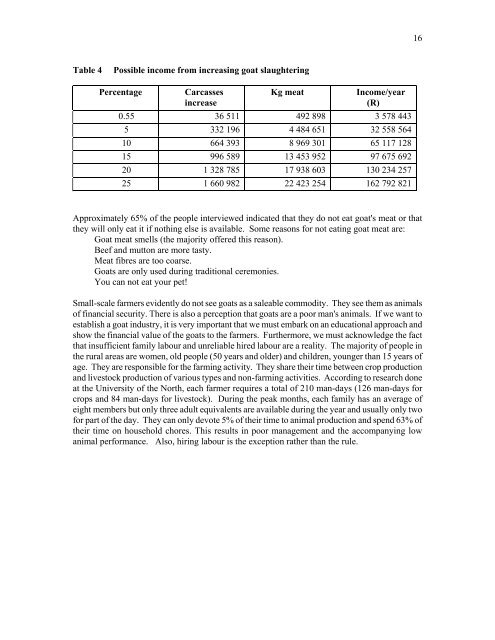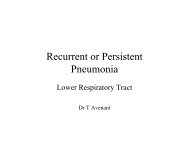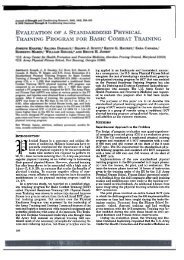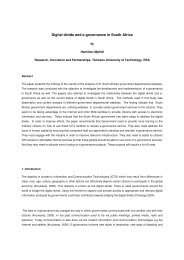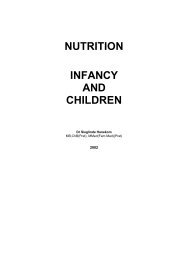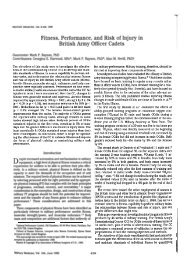Research and Training Strategies for Goat Production Systems in ...
Research and Training Strategies for Goat Production Systems in ...
Research and Training Strategies for Goat Production Systems in ...
Create successful ePaper yourself
Turn your PDF publications into a flip-book with our unique Google optimized e-Paper software.
Table 4 Possible <strong>in</strong>come from <strong>in</strong>creas<strong>in</strong>g goat slaughter<strong>in</strong>g<br />
Percentage Carcasses<br />
<strong>in</strong>crease<br />
Kg meat Income/year<br />
(R)<br />
0.55 36 511 492 898 3 578 443<br />
5 332 196 4 484 651 32 558 564<br />
10 664 393 8 969 301 65 117 128<br />
15 996 589 13 453 952 97 675 692<br />
20 1 328 785 17 938 603 130 234 257<br />
25 1 660 982 22 423 254 162 792 821<br />
Approximately 65% of the people <strong>in</strong>terviewed <strong>in</strong>dicated that they do not eat goat's meat or that<br />
they will only eat it if noth<strong>in</strong>g else is available. Some reasons <strong>for</strong> not eat<strong>in</strong>g goat meat are:<br />
<strong>Goat</strong> meat smells (the majority offered this reason).<br />
Beef <strong>and</strong> mutton are more tasty.<br />
Meat fibres are too coarse.<br />
<strong>Goat</strong>s are only used dur<strong>in</strong>g traditional ceremonies.<br />
You can not eat your pet!<br />
Small-scale farmers evidently do not see goats as a saleable commodity. They see them as animals<br />
of f<strong>in</strong>ancial security. There is also a perception that goats are a poor man's animals. If we want to<br />
establish a goat <strong>in</strong>dustry, it is very important that we must embark on an educational approach <strong>and</strong><br />
show the f<strong>in</strong>ancial value of the goats to the farmers. Furthermore, we must acknowledge the fact<br />
that <strong>in</strong>sufficient family labour <strong>and</strong> unreliable hired labour are a reality. The majority of people <strong>in</strong><br />
the rural areas are women, old people (50 years <strong>and</strong> older) <strong>and</strong> children, younger than 15 years of<br />
age. They are responsible <strong>for</strong> the farm<strong>in</strong>g activity. They share their time between crop production<br />
<strong>and</strong> livestock production of various types <strong>and</strong> non-farm<strong>in</strong>g activities. Accord<strong>in</strong>g to research done<br />
at the University of the North, each farmer requires a total of 210 man-days (126 man-days <strong>for</strong><br />
crops <strong>and</strong> 84 man-days <strong>for</strong> livestock). Dur<strong>in</strong>g the peak months, each family has an average of<br />
eight members but only three adult equivalents are available dur<strong>in</strong>g the year <strong>and</strong> usually only two<br />
<strong>for</strong> part of the day. They can only devote 5% of their time to animal production <strong>and</strong> spend 63% of<br />
their time on household chores. This results <strong>in</strong> poor management <strong>and</strong> the accompany<strong>in</strong>g low<br />
animal per<strong>for</strong>mance. Also, hir<strong>in</strong>g labour is the exception rather than the rule.<br />
16


